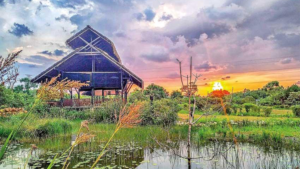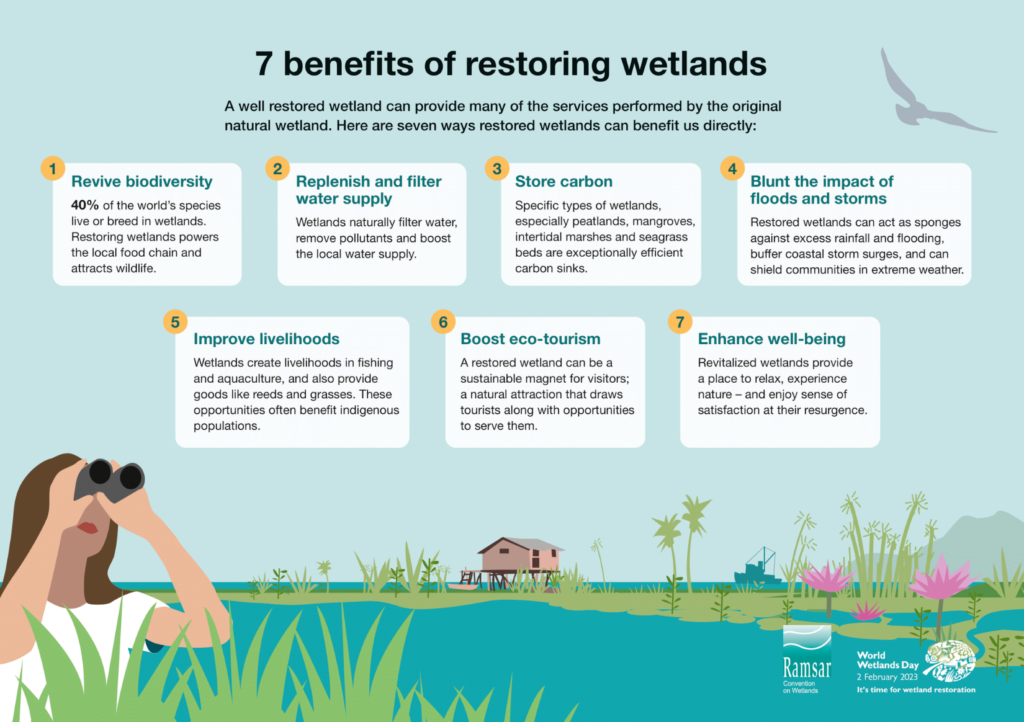Physical Address
23,24,25 & 26, 2nd Floor, Software Technology Park India, Opp: Garware Stadium,MIDC, Chikalthana, Aurangabad, Maharashtra – 431001 India
Physical Address
23,24,25 & 26, 2nd Floor, Software Technology Park India, Opp: Garware Stadium,MIDC, Chikalthana, Aurangabad, Maharashtra – 431001 India

Today, the 2nd of February, is World Wetland Day, where people celebrate the ecosystems that benefit people, animals, and the environment.This year`s theme is "It`s Time for Wetlands Restoration”, highlighting the urgent need to prioritize wetland restoration
This Article includes,
An overview of wetlands in Sri Lanka
Wetlands are habitats with a permanent or temporary water accumulation with associated floral and faunal communities, according to the National Wetland Directory of Sri Lanka.
The Ramsar definition of wetlands is “Areas of marsh, fen, peat land or water, whether natural or artificial, permanent or temporary with water that is static or flowing, fresh, brackish or salt, including areas of marine water the depth of which at low tide does not exceed six meters.”
Accordingly, wetlands in Sri Lanka can be divided into three broad categories:

Sri Lanka being an Island nation has 41 wetland sites of international importance covering a total of 274,000 hectares according to the Asian Wetland Directory records. Wetlands are integral to Sri Lanka’s unique ecological and biological diversity and are vital habitats for many fauna and flora.
The Climate Fact Checks team spoke to Dr. Chethika Gunasiri from Sri Lanka Land Development Corporation about the future of wetlands in Sri Lanka. She is an environmental professional with more than 10 years of experience in the field of ecosystem management, focused on urban areas. Her experiences include research, policy and planning, project design and implementation, disseminating knowledge, and raising awareness.
The relationship between Wetlands and Climate Change
Dr. Chethika stated that wetlands contribute to climate change mitigation and adaptation in different ways. When considering climate change mitigation, she mentioned, “Wetlands are good carbon sinks due to the abundance of vegetation and algal communities, biogeochemical cycles that occur in the shallow waters, and wetland soil is capable of absorbing carbon.”
Peatlands are considered as most effective carbon sinks in the world; in Sri Lanka, peatlands cover a total area of 2500 hectares, where a significant portion of it spreads in the western coast of the country through Muthurajawela wetland, which is the largest wetland in the country extending from Colombo to Negombo.
In addition, Dr.Chethika stated that “in Sri Lanka, seagrass beds also contribute greatly to carbon sequestration as it is found in shallow marine waters.” She added that the destruction of wetlands could release the carbon trapped within them into the atmosphere, contributing to Climate Change.
Sri Lanka Is considerably vulnerable to the adverse impacts of Climate Change, mainly due to flash floods, droughts, and other extreme weather conditions. “Wetlands play a vital role in Sri Lanka, acting as flood retention areas, especially in cities. They act as a sponge; for example, the Colombo wetland alone captures 37% of the rainfall preventing the risk of flash floods,” she added.
Hence wetlands play a crucial role in disaster risk reduction. Dr. Chethika also stated that wetlands help improve food security “Urban wetlands are closely related with paddy and vegetable farms, and in addition provide livelihoods like fisheries” In addition, wetlands are vital to maintaining the hydrological cycle, absorbing and storing fresh water, which also helps safeguard the food security.
Here are some more additional benefits of restoring wetlands as listed by IWMI.

How wetlands in Sri Lanka are threatened
Wetlands are diverse, productive ecosystems with ecological and economic value. Unfortunately, many wetlands in Sri Lanka, especially in the urban areas, are being exploited due to the different values it carries. However, these wetlands ecosystems are susceptible and have unique biodiversity, which is harshly impacted due to these anthropogenic activities.
Dr. Chethika mentioned that among the many threats that these wetlands face, they mainly fall under two broad categories,
“Wetlands can purify the water, yet it has a capacity which has now been exceeded.” She added. “Many wetlands have been converted to terrestrial lands; this disturbs the structure of these ecosystems and the many services they provide.”
Ways to conserve and sustainably utilize wetlands.
In Sri Lanka, the wetlands are found in urban and rural areas, which need different management strategies based on socioeconomic status and regional development activities.
Dr. Chethika mentions that the approach to be used within the urban areas based on the ongoing activities is ensuring that people from around the wetlands build a valued connection with it, “We are experimenting with different models at different wetlands, which connects the different activities of people with the wetland which will give them a sense of ownership to protect it.” She explains the need for urban wetlands to be integrated with urban planning.
Furthermore, Dr. Chethika added that some wetlands need more robust protection strategies and even designate them as protected areas; for example, Kotte, Kolonnawa, and Heenela were named sanctuaries that will control the activities of people within these wetlands.
The Conservation strategies and models used for each wetland depend on the environment surrounding it and the services it provides. Hence, a single conservation strategy can only be placed to protect some wetlands.
Furthermore, these ecosystems are rich in resources that push people to exploit them, yet they need to be used sustainably. Hence, it is essential to identify the different ecosystem services of each wetland individually and make locals aware of the long-term importance.
Bundala, Wilpattu, Kumana, Anavilundava, Vankalei, and Madu Ganga have been designated national parks and sanctuaries of international importance as the main RAMSAR Wetlands in Sri Lanka.
Dr. Chethika mentioned that although Sri Lanka identifies these wetlands as Internationally important, they are not legally bound to be conserved. Hence, events that occurred in the past, like the clearance of Anawilundawa Sanctuary and the ongoing debate on whether Vanakali and Vedithalathiv wetlands should be used for shrimp farming, are left unanswered. She stressed the importance of robust provisions in the national legal system to protect these important ecosystems.
The Ministry of Environment and the Central Environment Authority of Sri Lanka put forward the National Wetland Policy and Strategy in October 2006. In addition, the Nationally Determined Contribution of Sri Lanka includes commitments to improve urban wetlands.
Future of Wetlands in Sri Lanka.
The wildlife department has initiated a mangrove restoration project. Dr. Chethika elaborated more on the urban sector’s wetland restoration plans, stating that they are included in the urban planning strategies. She added that wetland ecosystem services are incorporated into city activities by collaborating with government organizations and all relevant stakeholders.
There are several methods implemented to remove Invasive Alien Plant Species. A significant focus is given to bringing international and national recognition to wetlands in Sri Lanka, which will help protect them.
Moreover, a Water body restoration project has been implemented within Colombo to improve the water quality of wetlands. She concluded by saying that the future of wetlands will be highlighted in urban planning and designing strategies.
Comments are closed.
Very interesting information!Perfect just what I was looking for! “He who spares the wicked injures the good.” by Seneca.
Hi climatefactchecks.org webmaster, You always provide helpful information.
Hello climatefactchecks.org owner, You always provide practical solutions and recommendations.
Hello climatefactchecks.org admin, Your posts are always well researched and well written.